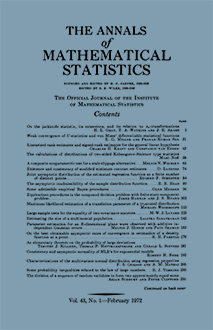Abstract
Analyses of variance are sometimes intended to reveal information about means (when tests of significance and, better, confidence procedures are appropriate). At other times analyses of variance have the purpose indicated by their name: to estimate the sizes of the various components contributed to the over-all variance from the corresponding sources. If we make certain assumptions of independence and normality for all of the quantities involved, it is easy to obtain formulas for the variances of the natural estimates of these variance components. The utility of these estimates can be called in question on the grounds of three sorts of assumptions: of certain amounts of independence, of infinite populations, of normality of distribution. This paper treats of the case where the latter two of these assumptions are removed, leaving only the customary (and dangerous) independence assumptions (as do the next two papers in this series). The treatment makes intensive use of polykays (which were introduced in [1], although that name was not used, and discussed in [2]) and is applied specifically to balanced single and double classifications, to Latin squares, and to balanced incomplete blocks. A general definition of balance for an analysis of variance situation is given, and the general application of the technique to balanced situations is set forth. An application to a less simple example of a balanced single classification concludes the paper.
Citation
John W. Tukey. "Variances of Variance Components: I. Balanced Designs." Ann. Math. Statist. 27 (3) 722 - 736, September, 1956. https://doi.org/10.1214/aoms/1177728179
Information





